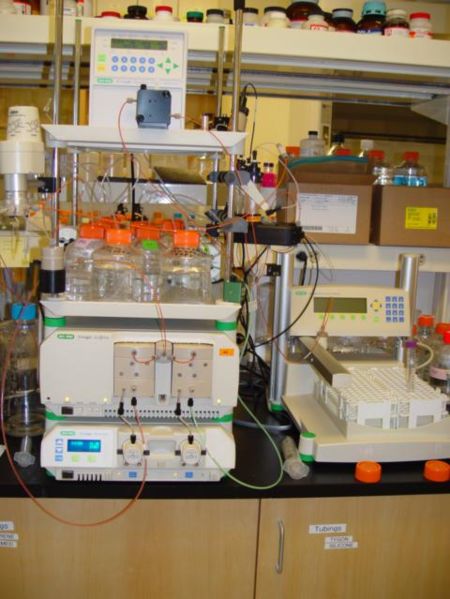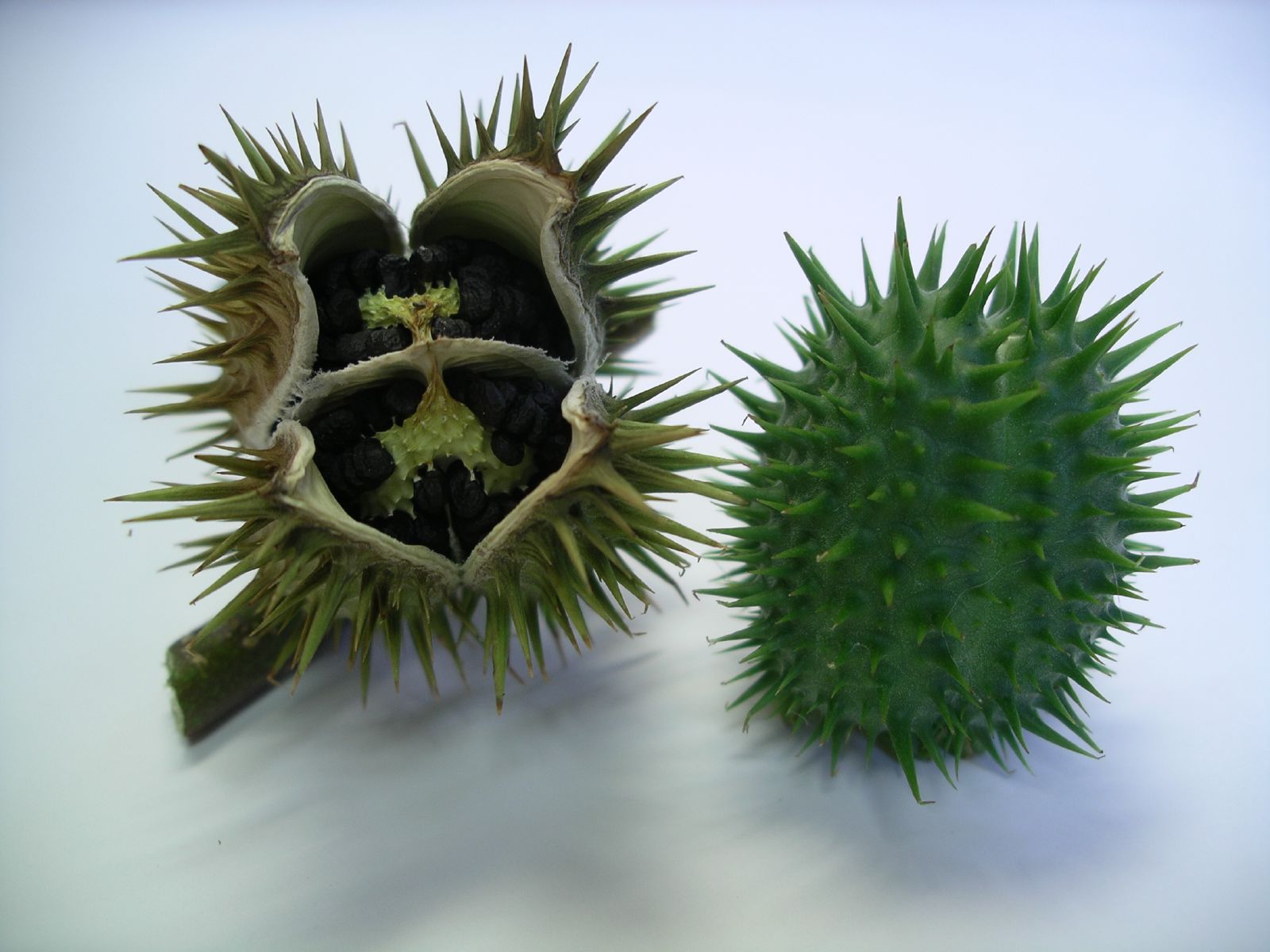|
Tobacco Etch Virus
Tobacco etch virus (TEV) is a plant virus in the genus ''Potyvirus'' and family ''Potyviridae''. Like other members of the genus ''Potyvirus'', TEV has a monopartite positive-sense, single-stranded RNA genome surrounded by a capsid made from a single viral encoded protein. The virus is a filamentous particle that measures about 730 nm in length. It is transmissible in a non-persistent manner by more than 10 species of aphids including ''Myzus persicae''. It also is easily transmitted by mechanical means but is not known to be transmitted by seeds. Host range This virus infects many species of Solanaceae. Agriculturally important crops that it infects include several species of ''Capsicum'' (i.e. '' C. annuum'', '' C. frutescens''), tomato (''Lycopersicon esculentum''), and tobacco (''Nicotiana spp.''). It also infects many perennial weed species that can act as virus reservoirs for susceptible agricultural crops. These weed species include ''Solanum nigrum'' (nightshade) ... [...More Info...] [...Related Items...] OR: [Wikipedia] [Google] [Baidu] |
Burley Tobacco
Burley tobacco is a light air-cured tobacco used primarily for cigarette production. In the United States it is produced in an eight-state belt with approximately 70% produced in Kentucky. Tennessee produces approximately 20%, with smaller amounts produced in Indiana, North Carolina, Missouri, Ohio, Virginia, Maryland, Pennsylvania and West Virginia. Burley tobacco is produced in many other countries, with major production in Brazil, Malawi and Argentina. History The origin of white burley tobacco was credited to George Webb and Joseph Fore in 1864, who grew it on the farm of Captain Frederick Kautz near Higginsport, Ohio, from seed from Bracken County, Kentucky. He noticed it yielded a different type of light leaf shaded from white to yellow, and cured differently. By 1866, he had harvested 20,000 pounds of burley tobacco and sold it in 1867 at the St. Louis Fair for $58 per hundred pounds. By 1883, Cincinnati had become the principal market for this tobacco, and it was grow ... [...More Info...] [...Related Items...] OR: [Wikipedia] [Google] [Baidu] |
Perennial Plant
A perennial plant or simply perennial is a plant that lives more than two years. The term ('' per-'' + '' -ennial'', "through the years") is often used to differentiate a plant from shorter-lived annuals and biennials. The term is also widely used to distinguish plants with little or no woody growth (secondary growth in girth) from trees and shrubs, which are also technically perennials. Perennialsespecially small flowering plantsthat grow and bloom over the spring and summer, die back every autumn and winter, and then return in the spring from their rootstock or other overwintering structure, are known as herbaceous perennials. However, depending on the rigours of local climate (temperature, moisture, organic content in the soil, microorganisms), a plant that is a perennial in its native habitat, or in a milder garden, may be treated by a gardener as an annual and planted out every year, from seed, from cuttings, or from divisions. Tomato vines, for example, live several y ... [...More Info...] [...Related Items...] OR: [Wikipedia] [Google] [Baidu] |
Affinity Chromatography
Affinity chromatography is a method of separating a biomolecule from a mixture, based on a highly specific macromolecular binding interaction between the biomolecule and another substance. The specific type of binding interaction depends on the biomolecule of interest; antigen and antibody, enzyme and substrate, receptor and ligand, or protein and nucleic acid binding interactions are frequently exploited for isolation of various biomolecules. Affinity chromatography is useful for its high selectivity and resolution of separation, compared to other chromatographic methods. Principle Affinity chromatography has the advantage of specific binding interactions between the analyte of interest (normally dissolved in the mobile phase), and a binding partner or ligand (immobilized on the stationary phase). In a typical affinity chromatography experiment, the ligand is attached to a solid, insoluble matrix—usually a polymer such as agarose or polyacrylamide—chemically modified ... [...More Info...] [...Related Items...] OR: [Wikipedia] [Google] [Baidu] |
Polyhistidine-tag
A polyhistidine-tag is an amino acid motif in proteins that typically consists of at least six histidine (''His'') residues, often at the N- or C-terminus of the protein. It is also known as hexa histidine-tag, 6xHis-tag, His6 tag, by the US trademarked name HIS TAG (US Trademark serial number 74242707), and most commonly as His-Tag. The tag was invented by Roche, although the use of histidines and its vectors are distributed by Qiagen. Various purification kits for histidine-tagged proteins are available from Qiagen, Sigma-Aldrich Corporation, Sigma, Thermo Scientific, GE Healthcare, Macherey-NagelCube Biotech Clontech, Bio-Radand others. MK(HQ)6 may be used for enhanced expression in ''E. coli'' and tag removal. The total number of histidine residues may vary in the tag from as low as two, to as high as 10 or more His residues. N- or C-terminal His-tags may also be followed or preceded, respectively, by a suitable amino acid sequence that facilitates removal of the polyhistidine ... [...More Info...] [...Related Items...] OR: [Wikipedia] [Google] [Baidu] |
Affinity Tag
Protein tags are peptide sequences genetically grafted onto a recombinant protein. Tags are attached to proteins for various purposes. They can be added to either end of the target protein, so they are either C-terminus or N-terminus specific or are both C-terminus and N-terminus specific. Some tags are also inserted at sites within the protein of interest; they are known as internal tags. Affinity tags are appended to proteins so that they can be purified from their crude biological source using an affinity technique. Affinity tags include chitin binding protein (CBP), maltose binding protein (MBP), Strep-tag and glutathione-S-transferase (GST). The poly(His) tag is a widely used protein tag, which binds to matrices bearing immobilized metal ions. Solubilization tags are used, especially for recombinant proteins expressed in species such as '' E. coli'', to assist in the proper folding in proteins and keep them from aggregating in inclusion bodies. These tags include thior ... [...More Info...] [...Related Items...] OR: [Wikipedia] [Google] [Baidu] |
Protein Purification
Protein purification is a series of processes intended to isolate one or a few proteins from a complex mixture, usually cells, tissues or whole organisms. Protein purification is vital for the specification of the function, structure and interactions of the protein of interest. The purification process may separate the protein and non-protein parts of the mixture, and finally separate the desired protein from all other proteins. Ideally, to study a protein of interest, it must be separated from other components of the cell so that contaminants won't interfere in the examination of the protein of interest's structure and function. Separation of one protein from all others is typically the most laborious aspect of protein purification. Separation steps usually exploit differences in protein size, physico-chemical properties, binding affinity and biological activity. The pure result may be termed protein isolate. Purpose The protein manufacturing cost remains high and there is a g ... [...More Info...] [...Related Items...] OR: [Wikipedia] [Google] [Baidu] |
New World
The term ''New World'' is often used to mean the majority of Earth's Western Hemisphere, specifically the Americas."America." ''The Oxford Companion to the English Language'' (). McArthur, Tom, ed., 1992. New York: Oxford University Press, p. 33: "[16c: from the feminine of ''Americus'', the Latinized first name of the explorer Amerigo Vespucci (1454–1512). The name ''America'' first appeared on a map in 1507 by the German cartographer Martin Waldseemüller, referring to the area now called Brazil]. Since the 16c, a name of the western hemisphere, often in the plural ''Americas'' and more or less synonymous with ''the New World''. Since the 18c, a name of the United States of America. The second sense is now primary in English: ... However, the term is open to uncertainties: ..." The term gained prominence in the early 16th century, during Europe's Age of Discovery, shortly after the Italian explorer Amerigo Vespucci concluded that America (now often called ''the Am ... [...More Info...] [...Related Items...] OR: [Wikipedia] [Google] [Baidu] |
Physalis
''Physalis'' (, , , , from φυσαλλίς ''phusallís'' "bladder") is a genus of approximately 75 to 90 flowering plants in the Solanum, nightshade family (biology), family (Solanaceae), which are native to the Americas and Australasia. At least 46 species are endemism, endemic to Mexico. Cultivated and weedy species have been introduced worldwide. A defining feature of ''Physalis'' is a large, papery husk derived from the sepal, calyx, which partly or fully encloses the fruit. Many species bear edible fruit, and some species are cultivated. The typical ''Physalis'' fruit is similar to a firm tomato in texture, and like strawberry, strawberries or pineapple in flavor, with a mild acidity. Some species, such as the Physalis peruviana, Cape gooseberry and tomatillo, have been bred into many cultivars with varying flavors, from tart to sweet to savory. Nations including Colombia, India, and Mexico have a significant economic trade in ''Physalis'' fruit. The fruit of many species ... [...More Info...] [...Related Items...] OR: [Wikipedia] [Google] [Baidu] |
Linaria Canadensis
''Nuttallanthus canadensis'', the blue toadflax, Canada toadflax, or old-field toadflax, is a species of '' Nuttallanthus'' in the family Plantaginaceae, native to eastern North America from Ontario east to Nova Scotia and south to Texas and Florida.USDA Plants Profile''Nuttallanthus canadensis''/ref> Description It is an annual or biennial plant growing to 25–80 cm tall, with slender, erect flowering stems. The leaves are slender, 15–30 mm long and 1–2.5 mm broad. The flowers are purple to off-white, 10–15 mm long, appearing from mid spring to late summer.Huxley, A, ed. (1992). ''New RHS Dictionary of Gardening''. Distribution and habitat It is grown as an ornamental plant in its native area. It has been introduced to western North America and Europe, and is now locally naturalized, from Washington south to California, and also in Russia. It typically grows in bare areas and grassland. Ecology The plant is a nectar source for bees and butterflies. I ... [...More Info...] [...Related Items...] OR: [Wikipedia] [Google] [Baidu] |
Datura Stramonium
''Datura stramonium'', known by the common names thorn apple, jimsonweed (jimson weed), devil's snare, or devil's trumpet, is a poisonous flowering plant of the nightshade family Solanaceae. It is a species belonging to the ''Datura'' genus and '' Daturae'' tribe. Its likely origin was in Central America, and it has been introduced in many world regions. It is an aggressive invasive weed in temperate climates across the world. ''D. stramonium'' has frequently been employed in traditional medicine to treat a variety of ailments. It has also been used as a hallucinogen (of the anticholinergic/antimuscarinic, deliriant type), taken entheogenically to cause intense, sacred or occult visions.Schultes, Richard Evans; Albert Hofmann (1979). ''Plants of the Gods: Origins of Hallucinogenic Use'' New York: McGraw-Hill. . It is unlikely ever to become a major drug of abuse owing to effects upon both mind and body frequently perceived as being highly unpleasant, giving rise to a state of ... [...More Info...] [...Related Items...] OR: [Wikipedia] [Google] [Baidu] |
Chenopodium Album
''Chenopodium album'' is a fast-growing weedy annual plant in the genus ''Chenopodium''. Though cultivated in some regions, the plant is elsewhere considered a weed. Common names include lamb's quarters, melde, goosefoot, wild spinach and fat-hen, though the latter two are also applied to other species of the genus ''Chenopodium'', for which reason it is often distinguished as white goosefoot.BSBIDatabase of names (xls file) ''Chenopodium album'' is extensively cultivated and consumed in Northern India, Nepal, and Pakistan as a food crop known as ''bathua''. Distribution Its native range is obscure due to extensive cultivation, but includes most of Europe,Flora Europaea''Chenopodium album''/ref> from where Linnaeus described the species in 1753.Linnaeus, C. (1753). ''Species Plantarum'' 1: 219Facsimile Plants native in eastern Asia are included under ''C. album'', but often differ from European specimens.Flora of China''Chenopodium album''/ref> It is widely naturalised elsewher ... [...More Info...] [...Related Items...] OR: [Wikipedia] [Google] [Baidu] |




